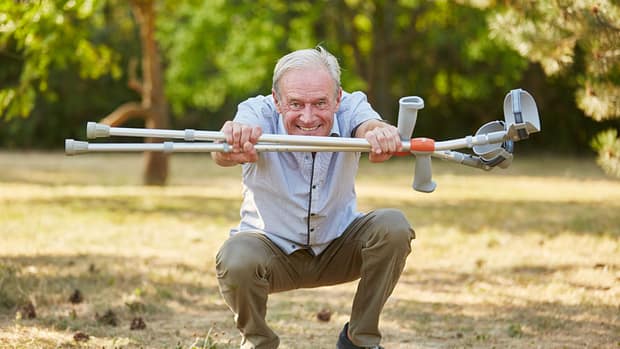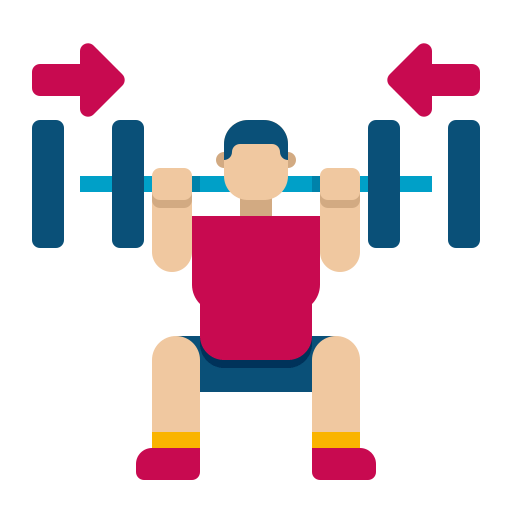Hey there, fitness enthusiasts and curious minds! 🏋️♀️🧘♂️ Have you ever wondered if there are certain situations when squatting might not be the best exercise choice?
We all know that squats are a fantastic way to build lower body strength and engage various muscle groups. But guess what?
Not everyone can dive into squatting without a second thought. There are instances where joint limitations play a significant role in determining whether squatting is a good idea or a potential risk.
So, grab a seat (or stand if you’re in the mood), because in this blog post, we’re going to delve into who might need to be a bit more cautious or skip squats altogether.
Let’s explore the world of joints, limitations, and the smart ways to navigate them when it comes to squatting! 💪🦵
Due to joint limitations: Which people should avoid squats?
Individuals with certain joint limitations should be cautious or avoid squatting exercises, as these movements can put stress on the joints and potentially worsen their condition.
Here are some specific cases in which people might need to be cautious about squatting:
Severe Knee Issues: Individuals with severe knee problems, such as advanced osteoarthritis or ligament injuries, might find squatting painful and detrimental to their joint health.
Hip Impingement: People with hip impingement, a condition where the hip joint doesn’t move smoothly due to bone abnormalities, might experience discomfort or pain while squatting.
Ankle Mobility Issues: Poor ankle mobility can lead to improper squatting form and increased stress on the knees. Those with severe ankle limitations should approach squatting cautiously.
Spinal Issues: Individuals with spinal conditions like herniated discs, spinal stenosis, or other back problems might find squatting exacerbates their condition due to the pressure placed on the spine.
Shoulder Problems: Individuals with significant shoulder issues, such as rotator cuff injuries or frozen shoulder, might struggle to maintain proper upper body positioning during squats.
Balance and Stability Issues: People with poor balance or stability might find squatting challenging, increasing the risk of falling or injury.

Pregnancy: Pregnant individuals, especially in the later stages of pregnancy, might have difficulty squatting due to changes in their center of gravity and the strain it places on the lower back and pelvis.
Recent Surgeries: Those who have recently undergone joint-related surgeries, such as knee or hip replacements, should consult their medical professional before attempting squatting exercises.
Medical Advice: Individuals who have been advised by their healthcare provider not to engage in squatting due to their specific medical conditions should heed that advice.
Note though that while squatting might not be suitable for some individuals with joint limitations, it doesn’t mean they can’t engage in other forms of exercise.
Consulting with a medical professional, physical therapist, or qualified fitness trainer can help individuals determine what exercises are safe and effective for their specific situation.
Explanations.
Let’s delve deeper, let me explain these points mentioned further.
Severe Knee Issues…
– Advanced Osteoarthritis and Ligament Injuries:
Advanced Osteoarthritis: Osteoarthritis is a degenerative joint condition that involves the breakdown of cartilage within the joints.
When the knee joint is affected by severe osteoarthritis, the protective cartilage wears away, causing pain, stiffness, and reduced joint function.
Squatting can exacerbate this pain by putting additional pressure on the affected joint surfaces, leading to discomfort and potential joint damage.
Ligament Injuries:
Ligaments are tough bands of tissue that connect bones to each other within a joint.
Injuries to the ligaments in the knee, such as an anterior cruciate ligament (ACL) tear, can result in instability and reduced joint support.
Squatting can strain these injured ligaments, potentially causing further damage and hindering the healing process.
Hip Impingement.
Bone Abnormalities: Hip impingement, also known as femoroacetabular impingement (FAI), occurs when there is an abnormality in the shape of the hip joint bones.
The ball-and-socket structure of the hip joint doesn’t move smoothly, leading to friction between the bones during movement.
When squatting, the hip joint flexes and moves through a range of motion. In individuals with hip impingement, this motion can cause discomfort or pain due to the bones rubbing against each other or against the cartilage lining the joint.
In both cases, squatting can exacerbate the discomfort or pain associated with these conditions due to the specific demands the movement places on the affected joints.
It’s important for individuals with these conditions to consult with their healthcare provider or a physical therapist before attempting squatting exercises.
These professionals can provide guidance on whether squatting is appropriate, modifications to consider, or alternative exercises that are safer and more suitable for their joint limitations.
Ankle Mobility Issues.
Ankle Joint Function: Ankle mobility refers to the ability of the ankle joint to move freely and efficiently through its full range of motion.
Proper ankle mobility is essential for maintaining balance and performing movements like squatting correctly.
Impact on Squatting:
During a squat, the ankles need to flex and extend to maintain proper form. If an individual has poor ankle mobility, they might struggle to achieve the necessary range of motion.
As a result, compensatory movements can occur, such as the heels lifting off the ground, which can lead to improper squatting mechanics.
These compensations can shift the load onto other areas, such as the knees, potentially increasing the risk of knee discomfort or injury.
Spinal Issues.
Herniated Discs: A herniated disc occurs when the soft, jelly-like center of a spinal disc pushes out through a crack in the tougher exterior.
Squatting can potentially exacerbate this condition by increasing pressure on the spinal discs.
The forward bending motion during a squat can compress the front of the discs, causing the herniated portion to press against nearby nerves, leading to pain, numbness, or weakness.
Spinal Stenosis:
Spinal stenosis is a narrowing of the spaces within the spine, which can put pressure on the spinal cord and nerves.
Squatting can exacerbate this condition by further compressing the spinal canal, leading to symptoms like pain, tingling, or numbness that radiate down the legs.
Other Back Problems:
Various other back problems, such as degenerative disc disease or spondylolisthesis, can also be aggravated by the spinal flexion and compression that occur during a squat.
In both cases, individuals with ankle mobility issues and those with spinal conditions should approach squatting with caution.
It’s advisable for them to consult with a healthcare professional or physical therapist to determine whether squatting is appropriate and how to modify the movement to minimize the risk of exacerbating their condition.
For those with severe limitations, alternative exercises that place less stress on the ankles or spine may be recommended to maintain overall fitness while protecting their joint and spinal health.
Shoulder Problems – Rotator Cuff Injuries and Frozen Shoulder:
Rotator Cuff Injuries: The rotator cuff is a group of muscles and tendons that stabilize and enable movement of the shoulder joint.
Injuries to these structures, such as tears or strains, can limit the ability to lift and move the arm comfortably.
During a squat, proper upper body positioning involves holding a barbell or maintaining arm posture.
Individuals with rotator cuff injuries might find it challenging to support the weight or maintain the required arm position, potentially worsening their shoulder discomfort or risking further injury.
Frozen Shoulder (Adhesive Capsulitis):
Frozen shoulder is a condition characterized by stiffness and reduced range of motion in the shoulder joint.
The limited mobility can make it difficult to achieve the arm positioning needed for proper squat form.
Squatting with a frozen shoulder can result in strain on the affected joint and potentially exacerbate the condition.
Balance and Stability Issues.
Balance and Stability: Balance refers to the ability to maintain an even distribution of weight and remain upright, while stability involves the body’s capacity to control movement and resist falling. Both are crucial for performing movements like squatting safely.
Impact on Squatting:
Squatting requires maintaining a stable and balanced position throughout the movement.
Individuals with poor balance or stability might struggle to keep their weight centered, potentially leading to wobbling or leaning excessively during the squat.
This instability increases the risk of losing control and falling, which could result in injuries, particularly if weights are involved.
In both cases, individuals with shoulder problems or balance and stability issues should approach squatting cautiously.
Consulting with a medical professional or a qualified fitness trainer can provide insights into whether squatting is appropriate and how to adapt the exercise to their specific needs.
If squatting is not suitable, alternative exercises that focus on lower body strength and stability, while minimizing stress on the shoulders or challenging balance, might be recommended.
Pregnancy.
Changes in Center of Gravity: During pregnancy, a woman’s body undergoes significant changes, including shifts in weight distribution and changes in the center of gravity due to the growing uterus.

This alteration in balance and stability can make squatting more challenging, especially in later stages of pregnancy.
Lower Back and Pelvic Strain:
As pregnancy progresses, hormonal changes can lead to increased flexibility in the joints and ligaments, including those in the lower back and pelvis.
Squatting involves flexing the hips and knees, which can strain the lower back and pelvis, particularly if the joints are already under stress due to pregnancy-related changes.
Risk of Falling:
Pregnancy can affect coordination and balance, increasing the risk of falls, especially as the belly grows larger.
Falling during a squat can pose a significant risk to both the pregnant individual and the developing fetus.
Recent Surgeries – Knee or Hip Replacements:
Recovery Period: After knee or hip replacement surgeries, the affected joints need time to heal and regain strength.
Squatting puts stress on these joints, and individuals who have undergone such surgeries should consult their healthcare provider before attempting squatting exercises during their recovery period.
Potential Strain:
Squatting too soon after joint replacement surgery can potentially strain the new joint, disrupt the healing process, and increase the risk of complications.
Modified Approaches:
Depending on the type of surgery and the recommendations of the surgeon or physical therapist, modified squatting techniques or alternative exercises may be introduced gradually as part of the rehabilitation process.
In both cases, it’s vital for pregnant individuals and those who have recently undergone joint-related surgeries to consult their healthcare providers before attempting squatting exercises.
Medical professionals can provide personalized guidance based on the individual’s health status and specific circumstances.
For pregnant individuals, alternative exercises that are gentler on the joints and offer better stability might be recommended.
For those recovering from joint surgeries, rehabilitation protocols will typically include exercises that promote healing and strengthen the muscles around the surgical site before progressing to more demanding movements like squatting.
Medical Advice.
Absolutely, individuals who have received specific medical advice from their healthcare provider not to engage in squatting exercises should prioritize and follow that advice.
Healthcare professionals have a comprehensive understanding of their patients’ medical history, current condition, and potential risks associated with certain activities, including squatting.
Medical advice is tailored to each individual’s unique circumstances and takes into consideration factors such as existing medical conditions, recent surgeries, injuries, and overall health. Disregarding this advice can lead to further complications, discomfort, or injury.
If a healthcare provider has advised against squatting, it’s essential to communicate openly with them and discuss any concerns or questions.
They can offer alternative exercises, therapeutic interventions, and guidance on how to maintain or improve physical fitness while minimizing the potential risks to their health.
Your healthcare provider’s recommendations should always be respected and followed to ensure the best possible outcome for your overall well-being.
A complete tabular on this topic here.
Here’s a tabular comparison of individuals who shouldn’t squat due to joint limitations:
| Condition | Explanation |
|---|---|
| Severe Knee Issues | Individuals with advanced osteoarthritis or ligament injuries may find squatting painful and detrimental to joint health. |
| Hip Impingement | People with hip impingement experience discomfort due to bone abnormalities affecting smooth hip joint movement. |
| Ankle Mobility Issues | Poor ankle mobility can lead to improper squatting form and increased stress on knees. |
| Spinal Issues | Individuals with herniated discs, spinal stenosis, or back problems may experience exacerbated conditions due to spinal pressure during squats. |
| Shoulder Problems | Those with rotator cuff injuries or frozen shoulder may struggle with maintaining proper upper body positioning during squats. |
| Balance and Stability Issues | Individuals with poor balance and stability might find squatting challenging, increasing the risk of falling or injury. |
| Pregnancy | Pregnant individuals, especially in later stages, may struggle with squatting due to changes in center of gravity and strain on lower back and pelvis. |
| Recent Surgeries | Individuals who have undergone joint-related surgeries, like knee or hip replacements, should consult their medical professional before squatting. |
| Medical Advice | Individuals advised by healthcare providers not to squat due to specific medical conditions should heed that advice. |
Please note that this table provides a concise overview of the conditions and explanations. If you need more in-depth information about each condition, feel free to refer to the previous responses.
Conclusion.
In conclusion, individuals with joint limitations should be cautious or avoid squatting exercises based on their specific conditions.
Severe knee issues, hip impingement, poor ankle mobility, spinal problems, shoulder problems, balance and stability issues, pregnancy, recent joint-related surgeries, and medical advice against squatting all warrant careful consideration.
It’s crucial to consult with healthcare professionals and fitness experts to determine safe and appropriate exercises that cater to individual needs and promote overall well-being.

Hey there, it’s Mike Rrsq, the Editor-in-Chief over at Jsquat.com, and I’m absolutely obsessed with all things squat fitness! I’ve been lucky enough to get some serious recognition for my work in this field. With a solid background in the fitness and wellness industry, I’ve been there right from the get-go, helping shape this website into what it is today.
You see, I’m not just the boss around here; I’m also a passionate contributor. I love sharing my insights through my articles, and trust me, they’re not your run-of-the-mill stuff. Each piece I write is a labor of love, filled with my expertise and real-world experience in the fitness universe. So, if you’re into fitness and looking for some inspiration, you’re in the right place!


